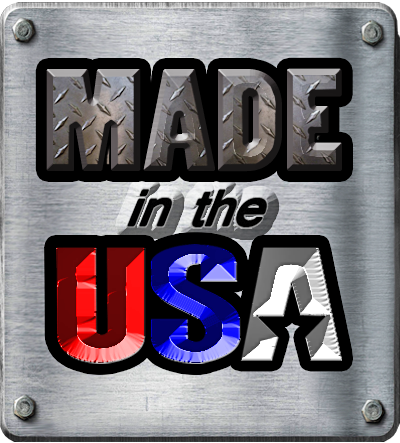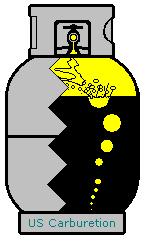Some Kit Order Links on individual pages are no longer functioning. We apologize for the inconvenience during this website update. If the ones on your page are not functioning, please verify what kit is available for your unit and then click this link KIT LIST PAGE FOR ALL GENERATORS AND ENGINES to go to this temporary kit listing page.
Portable Propane using 20# Cylinders and Larger
Propane 20# cylinders can be used to operate a generator portably. This is useful for all of the Kits available from our website. We have a hose kit for all kits to allow use of portable propane cylinders.
A common question we are asked is what pressure is my propane tank? Or what kit should I order, high or low pressure? The following should be helpful:
PROPANE CYLINDER LEGEND
BLACK AREA: Represents liquid propane which actually is as perfectly clear as water.
YELLOW AREA: Represents the vapor space and vapor is actually colorless.
YELLOW BUBBLES: Represent the vapor that is created when propane boils.
PROPANE TERMS FOR CYLINDERS AND TANKS*
 Tank Pressure Unregulated vapor pressure in any size propane tank can range from about 60 to 120 psi on average. This pressure is not consistent and fluctuates constantly based on the temperature of the propane and the draw of vapor from the upper vapor space. When the temperature of the liquid drops due to the boiling process, the pressure decreases. When the liquid warms the pressure increases. Due to this constant fluctuation and the fact that the engine fuel components operate best at steady input pressures, a regulator must be installed to keep the OUTLET pressure consistently the same or REGULATED. There are two types of regulators in the propane industry as described next.
Tank Pressure Unregulated vapor pressure in any size propane tank can range from about 60 to 120 psi on average. This pressure is not consistent and fluctuates constantly based on the temperature of the propane and the draw of vapor from the upper vapor space. When the temperature of the liquid drops due to the boiling process, the pressure decreases. When the liquid warms the pressure increases. Due to this constant fluctuation and the fact that the engine fuel components operate best at steady input pressures, a regulator must be installed to keep the OUTLET pressure consistently the same or REGULATED. There are two types of regulators in the propane industry as described next.  High Pressure Typically RED in color this regulator reduces the unregulated tank pressure to a constant outlet pressure between 8 to 12 psi (10 psi is average) no matter how much the tank pressure may fluctuate.
High Pressure Typically RED in color this regulator reduces the unregulated tank pressure to a constant outlet pressure between 8 to 12 psi (10 psi is average) no matter how much the tank pressure may fluctuate.  Low Pressure Within this category there are 2 different types. This regulator can be many different colors such as green, gray, brown, etc. and is a SECOND STAGE regulator designed to reduce the 10psi HIGH PRESSURE to a consistent 11" water column. Silver is also a low pressure regulator but is considered a SINGLE STAGE regulator because it will accept tank pressure and drop it to a consistent 11" water column.
Low Pressure Within this category there are 2 different types. This regulator can be many different colors such as green, gray, brown, etc. and is a SECOND STAGE regulator designed to reduce the 10psi HIGH PRESSURE to a consistent 11" water column. Silver is also a low pressure regulator but is considered a SINGLE STAGE regulator because it will accept tank pressure and drop it to a consistent 11" water column.
Other Characteristics of Propane and propane systems
 Liquid and Vapor: Propane is transported pumped and stored as a liquid. Most systems use vapor and 1 gallon of liquid propane will turn into 270 gallons of vapor gas. The process is easier to understand if it was water. Imagine an engine that could use steam vapor for power. Every gallon of water would make ? gallons of steam that could be burned. Propane is just like that and it has to boil to produce the vapor to be used.
Liquid and Vapor: Propane is transported pumped and stored as a liquid. Most systems use vapor and 1 gallon of liquid propane will turn into 270 gallons of vapor gas. The process is easier to understand if it was water. Imagine an engine that could use steam vapor for power. Every gallon of water would make ? gallons of steam that could be burned. Propane is just like that and it has to boil to produce the vapor to be used. Boiling Point: 44 degrees Fahrenheit below zero (Just as the boiling point for water is 212 degrees above)
Boiling Point: 44 degrees Fahrenheit below zero (Just as the boiling point for water is 212 degrees above) Recovery time: If propane vapor is pulled off very quickly the gas boils very rapidly to replenish the vapor. If the area directly around the liquid can not provide enough heat for the liquid to absorb, the liquid will basically turn into a gel and stop vaporizing. (In theory, a person could carry propane around in a bucket in 50 below zero Antarctica.) The result can be a cylinder that is 1/2 full but have no vapor pressure as if it were empty. When the gas warms up again it will replenish and the liquid will be usable again.
Recovery time: If propane vapor is pulled off very quickly the gas boils very rapidly to replenish the vapor. If the area directly around the liquid can not provide enough heat for the liquid to absorb, the liquid will basically turn into a gel and stop vaporizing. (In theory, a person could carry propane around in a bucket in 50 below zero Antarctica.) The result can be a cylinder that is 1/2 full but have no vapor pressure as if it were empty. When the gas warms up again it will replenish and the liquid will be usable again.  Propane Pressure:Most common domestic system use is at 11" water common (28 inches = 1 psi so 11" wc is just under one half of one psi)
Propane Pressure:Most common domestic system use is at 11" water common (28 inches = 1 psi so 11" wc is just under one half of one psi)
The size of the cylinder, how full it is, and the outside air temperature, all determine what size generator can be operated with any given cylinder.
As a general rule of thumb, a 10 horsepower engine will run fine on a 20# grill type cylinder if the ambient air temperature is above freezing. Larger engines require a larger cylinder. We have a device called a TC-18 that ties two cylinders together if needed which more than double the vaporization rate of two cylinders.
 20# cylinders hold approximately 5 gallons of propane.
20# cylinders hold approximately 5 gallons of propane.  30# cylinders hold approximately 7 gallons of propane.
30# cylinders hold approximately 7 gallons of propane.  40# cylinders hold approximately 10 gallons of propane.
40# cylinders hold approximately 10 gallons of propane.  100# cylinders hold approximately 25 gallons of propane.
100# cylinders hold approximately 25 gallons of propane.  420# cylinders hold approximately 100 gallons of propane.
420# cylinders hold approximately 100 gallons of propane.
ORDERING & QUESTIONS
Use your credit card and safely and securely order on-line. Or call our office toll free at :1-800-553-5608
Monday thru Friday9:00 am - 4:30 pm
Eastern Time.
You can place your order over the phone if you feel more comfortable doing that or if you would like to speak with a company representative to answer any further questions you may have.
Please check our BASIC INFO page first. 1-800-553-5608






